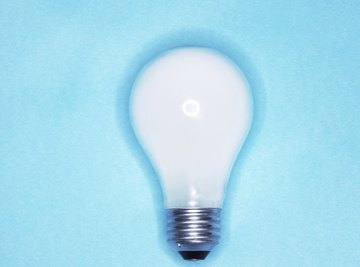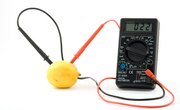
Fifth-grade students tend to enjoy experimenting with electricity, figuring out how it is generated, how it can be channeled, and learning about the array of its modern uses. Hands-on activities both simple and complex can liven up any 5th grade science curriculum. The activities, which can be performed as a class lesson or group project, require only inexpensive, easy to find materials. It is important that students participating in electrical projects and experiments be supervised by an adult at all times to ensure safety and proper use of equipment.
Light Bulb Comparison
Create an experiment to determine if a certain brand of light bulb gives more light than others. Compare five different brands of 60 watt light bulbs against one another. Conduct the tests using a light socket mounted inside a wooden box. Connect each of the five bulbs, one at a time, to the light socket. Keep the bulb lit for five seconds while a computer powered probe registers the amount of light outputted. Record and analyze the readings of the five brands, and invite students to draw their own conclusions about light strength and electricity channeling.
Lemon Battery
School children can work in groups or individually to create lemon batteries capable of conducting electricity. Supply each group with two 6-inch lengths of plastic coated wire, a copper nail, a zinc nail and a lemon. Have the students remove the plastic coating from each end of the wires, then wrap one end around a nail. The nails are then inserted into the lemon, close but not touching each other. Have the students touch the other bare end with their tongue or a wet finger to feel a slight tingle. The acid in the lemon causes positive and negative electric charges with the different metals, and the water in a tongue or wet finger conducts those charges.
Complete a Circuit
Creating a complete circuit demonstrates how to transmit electric charges from one point to another, and can be easily undertaken by fifth graders, with proper oversight. A C-battery, a piece of aluminum foil and a small flashlight light bulb are all the materials needed for this experiment. Fold a piece of aluminum foil into a 12-inch long, 1/2 inch wide strip. Place the battery on one end of the foil, then position the light bulb so that it is touching the other end of the battery and foil. The foil provides a path for the battery's energy to flow, which will cause the bulb to light up.
Static Electricity
Most children in the fifth grade have already been exposed to the static electricity created when a balloon rubs against human hair, or when clothes first come out of a hot dryer. This experiment demonstrates that same static electricity, but with a more advanced twist. Provide students with a balloon, Styrofoam packing peanuts and a piece of wool cloth. Have students rubs the inflated balloon with the cloth, then hold it slightly over the packing peanuts. Not only will the packing peanuts "leap" off of the table and onto the balloon, but if held long enough, they will leap back onto the table. The Styrofoam peanuts can be interchanged with puffed rice cereal or salt and pepper in this experiment.
References
About the Author
Residing in New Jersey, Grace Restivo is an aspiring writer who has been writing online professionally since 2010. Her articles specialize in reading, writing, computers, gardening, crafting, music, cooking, nutrition, gerontology, adoption and resume writing.
Photo Credits
Burke/Triolo Productions/Brand X Pictures/Getty Images
